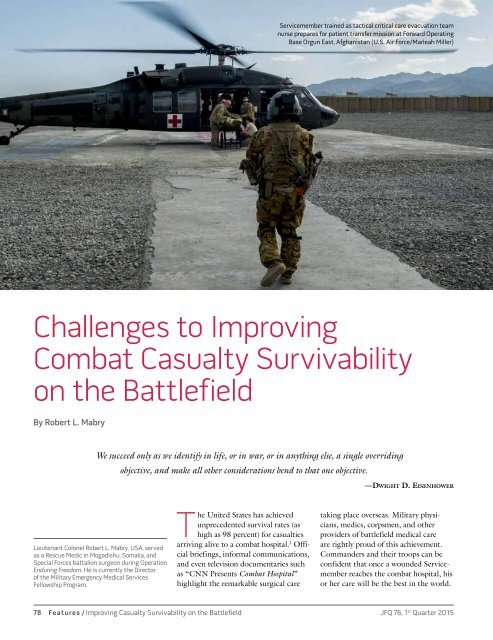jfq-76
jfq-76
jfq-76
Create successful ePaper yourself
Turn your PDF publications into a flip-book with our unique Google optimized e-Paper software.
Servicemember trained as tactical critical care evacuation team<br />
nurse prepares for patient transfer mission at Forward Operating<br />
Base Orgun East, Afghanistan (U.S. Air Force/Marleah Miller)<br />
Challenges to Improving<br />
Combat Casualty Survivability<br />
on the Battlefield<br />
By Robert L. Mabry<br />
We succeed only as we identify in life, or in war, or in anything else, a single overriding<br />
objective, and make all other considerations bend to that one objective.<br />
—Dwight D. Eisenhower<br />
Lieutenant Colonel Robert L. Mabry, USA, served<br />
as a Rescue Medic in Mogadishu, Somalia, and<br />
Special Forces battalion surgeon during Operation<br />
Enduring Freedom. He is currently the Director<br />
of the Military Emergency Medical Services<br />
Fellowship Program.<br />
The United States has achieved<br />
unprecedented survival rates (as<br />
high as 98 percent) for casualties<br />
arriving alive to a combat hospital. 1 Official<br />
briefings, informal communications,<br />
and even television documentaries such<br />
as “CNN Presents Combat Hospital”<br />
highlight the remarkable surgical care<br />
taking place overseas. Military physicians,<br />
medics, corpsmen, and other<br />
providers of battlefield medical care<br />
are rightly proud of this achievement.<br />
Commanders and their troops can be<br />
confident that once a wounded Servicemember<br />
reaches the combat hospital, his<br />
or her care will be the best in the world.<br />
78 Features / Improving Casualty Survivability on the Battlefield JFQ <strong>76</strong>, 1 st Quarter 2015




